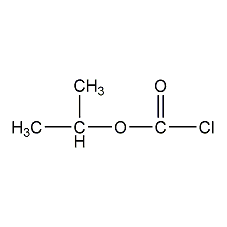
Structural formula
| Business number | 02WP |
|---|---|
| Molecular formula | C4H7ClO2 |
| Molecular weight | 122 |
| label |
Pesticide intermediates; aliphatic carboxylic acids and their derivatives |
Numbering system
CAS number:108-23-6
MDL number:MFCD00075068
EINECS number:203-563-2
RTECS number:LQ6475000
BRN number:506416
PubChem number:24860351
Physical property data
1. Properties: colorless liquid with pungent odor. [1]
2. Melting point (ºC): -80[2]
3. Boiling point (ºC): 104.6[3]
4. Relative density (water = 1): 1.08[4]
5. Relative vapor Density (air=1): 4.2[5]
6. Saturated vapor pressure (kPa): 3 (20ºC)[6]
7. Octanol/water partition coefficient: 1.04[7]
8. Flash point (ºC): 15.6; 20 (CC)[ 8]
9. Ignition temperature (ºC): >500[9]
10. Explosion limit (%): 15.0 [10]
11. Lower explosion limit (%): 4.0[11]
12. Solubility: insoluble in Water, soluble in most organic solvents such as ether, acetone, chloroform, etc. [12]
Toxicological data
1. Skin/eye irritation
Standard Draize test: rabbit, skin contact: 500mg.
Standard Draize test: Rabbit, Eye contact: 500 mg, Severity of reaction: Severe.
2. Acute toxicity: rat oral LD50: 1070mg/kg; rat inhalation LCLo: 200ppm/5H; mouse oral LD50: 178mg/kg; mouse skin contact LD50: 12mg /kg; Rabbit skin contact LD50: 11300mg/kg;
3. Other multiple dose toxicity: Rat by inhalation TCLo: 50ppm/6H/2W-I;
4. Acute toxicity[13]
LD50: 1070mg/kg (rat oral); 178mg/kg (small Rat oral); 11300mg/kg (rabbit transdermal)
LC50: 1504mg/m3 (mouse inhalation, 1h)
5. Irritation[14]
Rabbit transdermal: 500mg, causes irritation.
Rabbit eye: 500mg, severe irritation.
Ecological data
1. Ecotoxicity No data yet
2. Biodegradability[15] MITI-I test, initial concentration 100mg/L, sludge concentration 30mg/L, 51% degradation after 4 weeks.
3. Non-biodegradability[16]
Hydrolysis half-life at 12.5℃ is 32.6min (theoretical)
At 24.5℃, the hydrolysis half-life is 5.6min (theoretical)
Molecular structure data
1. Molar refractive index: 27.16
2. Molar volume (cm3/mol): 109.8
3. Isotonic specific volume (90.2K ): 251.8
4. Surface tension (dyne/cm): 27.6
5. Polarizability (10-24cm3): 10.76
Compute chemical data
1. Reference value for hydrophobic parameter calculation (XlogP): 2
2. Hydrogen bond supplyNumber of entities: 0
3. Number of hydrogen bond acceptors: 2
4. Number of rotatable chemical bonds: 2
5. Number of tautomers :None
6. Topological molecule polar surface area 26.3
7. Number of heavy atoms: 7
8. Surface charge: 0
9. Complexity: 70.1
10. Number of isotope atoms: 0
11. Number of determined atomic stereocenters: 0
12. Uncertain atoms Number of stereocenters: 0
13. Determine the number of stereocenters of chemical bonds: 0
14. Uncertain number of stereocenters of chemical bonds: 0
15. Number of covalent bond units: 1
Properties and stability
1. Isopropyl chloroformate is slightly less toxic than methyl chloroformate. But it is still highly toxic. Rat oral LD50<100mg/kg. Protection requirements are the same as for methyl chloroformate. See methyl chloroformate.
2. Stability[17] Stable
3. Incompatible substances[18] Strong oxidant, strong alkali, water
4. Conditions to avoid contact[19] Humid air, heat
5. Polymerization hazard[20] No polymerization
6. Decomposition products[21] Hydrogen chloride, phosgene
Storage method
Storage Precautions[22] Store in a cool, dry and well-ventilated warehouse. Keep away from fire and heat sources. The storage temperature should not exceed 37°C. The packaging must be sealed and must not come into contact with air. They should be stored separately from oxidants, alkalis, etc. and avoid mixed storage. Use explosion-proof lighting and ventilation facilities. It is prohibited to use mechanical equipment and tools that are prone to sparks. The storage area should be equipped with emergency release equipment and suitable containment materials.
Synthesis method
The preparation method is to add isopropyl alcohol into the phosgene kettle, start stirring, and then introduce phosgene through the phosgene flow meter. The temperature of the phosgene is about 30°C. Continue to pass the phosgene for several hours until the end point is near. After the sampling and analysis reaches the standard, the ventilation is stopped, and then nitrogen is passed to drive away the phosgene and hydrogen chloride, destroy the phosgene, and obtain the product by sampling and analyzing.
![]()
Purpose
1. Used as pesticide intermediate, ore flotation agent and initiator of free radical polymerization, such as the initiation of vinyl chloride polymerization.
2. Used as pesticide intermediates. [23]

 微信扫一扫打赏
微信扫一扫打赏

